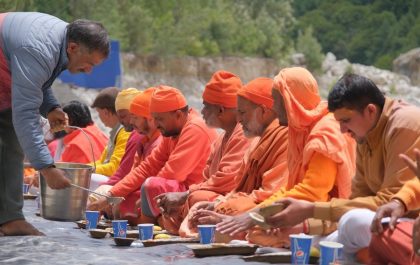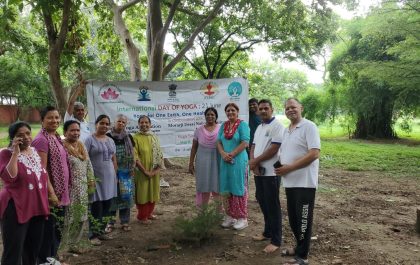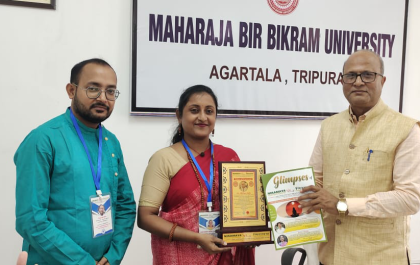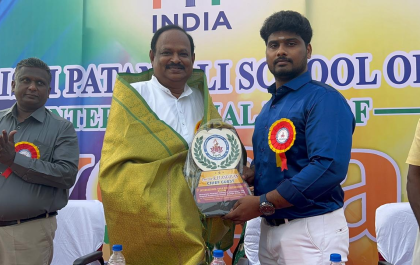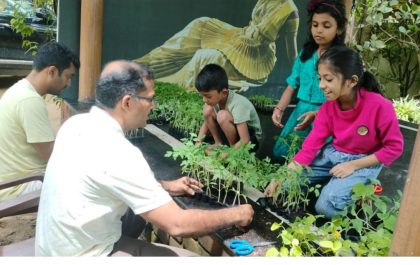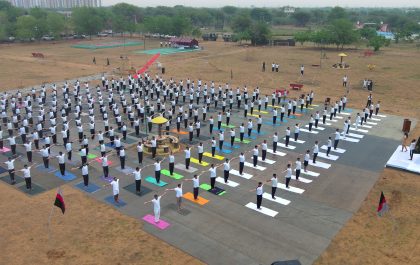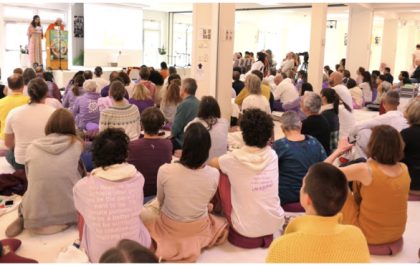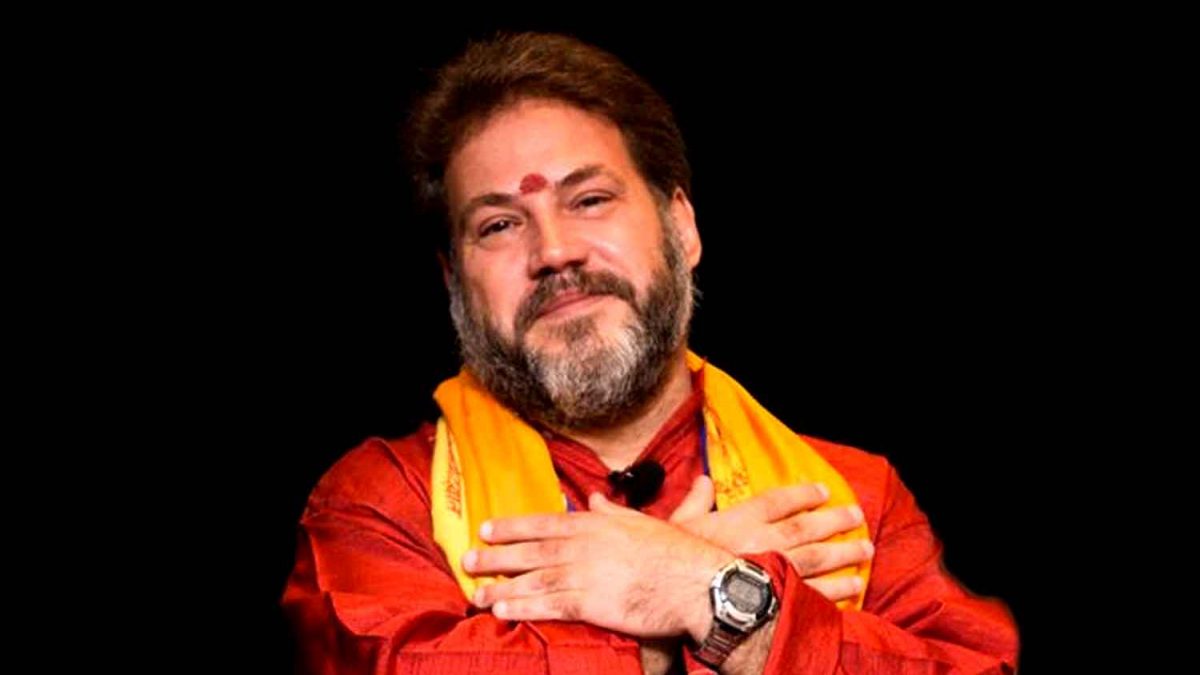According to Yogamaharishi Dr Swami Gitananda Giri Guru Maharaj, one of the foremost authorities on Rishiculture Ashtanga Yoga in the last century, Yoga is not only a science but is also the “Mother of all Sciences” because it contains within its vast ambit of ancient wisdom, amazing knowledge that has been subsequently pursued by all major branches of modern science. This includes astronomy and cosmology (the nature of the universe), physics (the fundamental science of matter), the world of chemistry, biology (the science of life) and the science of man including the science of health (spiritual, mental, emotional and physical).
Yoga can be understood as a body of knowledge (Yoga Vidya) handed down through millennia from Guru to Chela with its own technology (Yoga Vidhi). This has been gained through intense, systematic, introverted investigation into the workings of the human mind.
These results have been logically arranged in the form of the scriptures with the major hypothesis that the human in essence is the ‘Divine Being’ in potential form thus fully capable of experiencing Sat-Chit-Anandam.
This hypothesis further postulates that mind controls matter and hence, by controlling mind the human being may control matter. This further suggests that health and happiness are our birthright and that Moksha or freedom from all limitation, is the goal of human existence.
General Laws governing mind, emotions and body have been discovered though the thousands of years that this introverted investigation has been taking place thus discovering that living in conformity to these Cosmic Laws of Sanatana Dharma produces peace of mind, health, happiness and spiritual evolution.
The truth of this is proven as fact by the example of great Yogis who have lived in obedience to these laws. These laws were then taught to their disciples by these illustrious Yogis and passed on through various Guru Parampara.
Furthermore, the existence of these laws and the benefits of living in obedience to these laws may be discovered by all sincere disciplined aspirants by experimenting with the techniques taught by the Gurus.
Ammaji Yogacharini Meenakshi Devi Bhavanani, the Living Siddha of Puducherry and one of the most eminent Yoginis of modern times has described the science of Yoga as a distillation and sublimation of all the finest, most noble attitudes bequeathed as the legacy of the Rishis, a treasure trove of thoughts. The ancient scriptures of India such as the Vedas and Upanishads are the treasury house wherein are stored these precious thought forms for safe keeping.
She has rightly pointed out that the wise soul knows how to approach the keeper of this treasure and avail himself of the wealth of wisdom contained therein.
Ammaji’s is truly a practical mystic and makes every theoretical concept manifest practically. Hence, she created an excellent presentation for the science day exhibition at her granddaughter Dhivya Priya Bhavanani’s school on “Yoga: the Science of Holistic Health’. In this presentation she brought out a clear understanding of Yoga as a science by quoting the dictionary definition of science and then showing how Yoga fulfilled all of the criteria.
According to the Funk & Wagnall’s Standard College Dictionary science can be defined as:
- Any department of knowledge in which the results of investigation have been logically arranged and systematized in the form of hypotheses and general laws subject to verification.
- Knowledge of facts, phenomena, laws, and proximate causes, gained and verified by exact observation, organized experiment, and ordered thinking.
- An orderly presentation of facts, reasoning, doctrines, and beliefs concerning some subject or group of subjects: the science of theology.
Ammaji explained that upon careful analysis we can see that all the methods of science are followed in Yoga.
We have the terminology in the form of Sanskrit terms used to describe different phenomena as well as the technology in the form of excellent instruments (Asanas, Pranayama, Kriyas, Mudras, Bandhas, Shat Karma etc) to discover the ultimate truth and put these truths into practice to produce results.
We have the methodology of an experiential and experimental approach where one performs various physical and mental actions (Abhyasa) and observes the resultant effects with a dispassionate sense of objectivity (Vairagya).
Yoga also has an accumulated body of knowledge through millennia, the results of experiential and experimental studies by our great the Rishis as recorded in the Vedas, Upanishads, Puranas, Itihasas, Shastras etc.
The final aspect, the ‘proof of the pudding’ is that all of these experiences are open to verification. The findings may be verified by each sincere individual who decides to undertake the practices (Sadhana) advocated by the Rishis.
The characteristic of a science or Vidya is the approach and not merely content or quality of knowledge. Though Yoga has its foundations more than 5000 years ago and is principally an oral tradition, the verbal basis of Yoga-Vidya (Yogic Science) is found in the Upanishads (especially the Katha-Upanishad, Shvetashvatara-Upanishad and Maitrayaniya-Upanishad), the Yoga Sutras of Patanjali and the Bhagavad Gita.
According to Prof. TR Anantharaman, Founding President of the Indian Academy of Yoga, all of these Yoga scriptures are pre Buddhistic in nature and share a systematic and broad scientific basis. Katha Upanishad, one of the first written works on Yoga mentions the Yoga- Vidya (science of Yoga) and Yoga-Vidhi (the technological knowhow) of Yoga. The pure science of Yoga is Adhyatma Vidya (science of man in depth) while, the technology or applied science (rules of Yoga practice) that is, the technology of unification or integration, is called Yoga-Vidhi. The scientific attitude of Yoga can be seen from the firm insistence on Pariprasna (enquiry or dialogue) as a pre requisite to higher knowledge as enunciated in the Bhagavad Gita (IV.34).
Similarly the Yoga Sutras of Patanjali display a scientific attitude towards the acquisition of Pramana (true knowledge). Patanjali says that true knowledge can be acquired (Yoga Darshan I: 7) by direct perception (Pratyaksha), rational inference (Anumana) and from reliable testimony (Agama). This use of the intellect (Buddhi) endowed with discernment (Viveka) is typical of all Yoga traditions and their teachings. The Bhagavad Gita, often referred to as the Yoga Shastra, shows the exchange between Arjuna and Yogeshwar Krishna to be of a genuine spirit of enquiry and a keen desire for truth, as one would expect from a modern scientist and his guide.
The Shiva-Samhita (V.26–30) lists the characters of a fully qualified disciple (Sishya) as follows. “Endowed with great energy and enthusiasm, intelligent, heroic, learned in the scriptures, free from delusion…” Aren’t these very same qualities required by a true scientist (a seeker of true knowledge)?
The process of Yoga is one of the understanding and achievement of Mind Control. The Yogis discovered that the mind has many levels such as Mudha (dull and inert mind), Kshipta (distracted mind), Vikshipta (partially distracted mind), Ekagrata (concentrated mind) and Niruddha (controlled mind). They also found that the whirlpool like mental patterns (Chitta- Vritti) were five fold; namely Pramana (conception), Viparyaya (misconception), Vikalpa (imagination), Nidra (sleep) and Smrithi (memory).
They realized that without controlling these mental fluctuations there was no hope of conscious spiritual evolution.
This is why Maharishi Patanjali says in the Yoga Darshan, “Yoga is the stilling of the whirlpools of the subconscious/unconscious mind (yogash chittavritti nirodhah-I: 2). Once this is achieved the Yogin rests in his essential self (tada drishtu swarupevasthanamI: 3). The method to achieve this state is through dedicated and determined practice and dispassion (abyasa vairagyabhyam tannirodhah-I:12).
The Yogi follows a systematic practice (Abhyasa) of the eight fold path of Ashtanga (Raja) Yoga consisting of the moral restraints (Yama), ethical observances (Niyama), firm and comfortable postures (Asana), enhancement of the vital life force (Pranayama), control of the senses (Pratyahara), contemplative concentration (Dharana) leading into meditation (Dhyana) and ultimately transcending the individual self into the state of cosmic consciousness (Samadhi). This conscious evolution may take years and years (even lifetimes) of disciplined and dedicated practice (Abhyasa), detachment or dispassion (Vairagya) and loads of discrimination (Viveka). Through such a systematic manner, the Sadhaka (sincere and dedicated seeker of Truth) attempts to unite (Yuj) his individual self (Jivatma) with the universal self (Paramatma).
I end with a quote from my Guru-father Yogamaharishi Dr Swami Gitananda Giri Guru Maharaj who says, “Yoga is scientific and many of it practices can be measured by existing scientific methods. As a science of mind it offers a safe method of concentration and meditation educing a practical application of the power of the human mind. Its entire process is centered in awareness that is why I call it the science of awareness.”
Dr Ananda Balayogi Bhavanani
(Editor-in-Chief)
